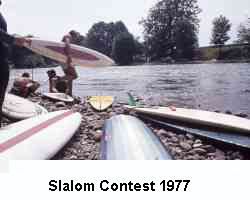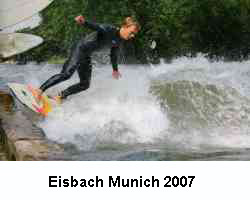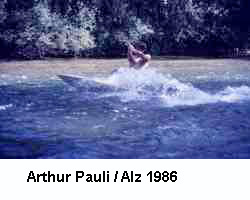









The history of Riversurfing is also a part of of the German surfing history as a whole.
The fascinating sport of surfing was the decisive stimulus for the „invention of river surfing“.
The Bavarian surfing pioneer Arthur G. Pauli tells his personal story:
I had my first encounter with a kind of „Fun"-Sport in the age of 10, when I watched some elder teens gliding sideways and even submerged temporarily, riding a square wooden board which was fixed to a bridge over a fast flowing canal: Aquaplaning
As I was already a good swimmer and water lover, it was a matter of course for me to try it out for myself. At the beginning of the Seventies photos of Hawaiian surfers were published now and then in German papers or TV. I was sixteen and totally stoked of those pictures. That was the time when the sport of surfing already experienced a veritable boom in California. The Beach Boys „surfed" to worldwide fame with songs like SURFIN' SAFARI und LET'S GO SURFIN. My favourite picture was the cover photo of the album SURFIN' USA, which shows a surfer on a big wave at the north shore of Oahu, Hawaii.
The Beginning
The ocean was too far away for me, but just behind our family home was the Alz river. I remembered the board riders on the canal and decided to combine this with the typical oval shape of a real surfboard. Im Summer 1965 I built my first „surfboard“, and was perhaps the first surfboard builder in Germany. It measured 2,20 meters in length, was made of wooden frames and plywood, coated with glass and polyester resin, and had two hooks on either side of its nose for a tow rope which in turn would be bound to a bridge or tree over the river.
However during the first test rides it turned out that when hooked under the high tree, the long and narrow board stood too high out of the water instead of planing. Gliding and steering was much easier, after I freed the board and took the tow rope into my own hands. Soon after some days of crossing to and fro in prone position, I managed to stand up and do this „slalom-like“ gliding in standing upright position.
The Surfboards
This surfing on the river made me hungry for trying the ocean surf. For this purpose I had do build a longer board with more buoyancy. A California cousin of mine sent me a copy of the SURFER magazine and arranged contact with a shaper of a big California surfboard brand, who -in a letter-correspondence course- tought me the basics of surfboard building and ocean wave surfing. Now I learnt that boards were built with polyurethane foam, and shaped my first foam-and-resin-board, perhaps the first longboard made in Germany. In summer 1966 I tested it successfully in the Adriatic Surf at Jesolo Beach near Venice, Italy.
Over the following years I improved my craftsmanship as "Foamer", "Shaper" and "Glasser" and finally produced boards in a variety of shapes for friends, who were, like myself, seized by the „surfing fever“. I even built short windsurf-bords for kids as that new sport became public in Germany.
Good slalom-spots along the rapid sections of the Alz river were (and still are) not easily accessible. So river surfing grew up as a „hidden“ sport, almost unnoticed by the public, and performed only by close friends, then the few members of the Surf Club Trostberg. It was only after the discovery of the „stationary“ wave at the raft landing in Munich-Thalkirchen, that the sport received more attention and publicity, since pedestrians, golfers from the near golf ground and guests of the adjacent campground could come close and watch.
In 1978 Munich surfers and river surfers founded the Verein Münchner Wellenreiter eV. On their then regular summer trips to the famous surf spots of France or Spain they happened to discovered the one or the other fine river spot, where „slalom“ was their game. Curious and exploring watermen , which had taken riversurf lessons at my home spots or who got infected by the „surf-virus“ after their first trials in the Munich wave, started searching their home regions for possible Slalom or wake surfing spots. So river surfing slowly spread.The "Bavarian Riversurfing Championships" were held for the first time in 1975 to find the best performers in both disciplines "Slalom" (with tow rope on the Alz river) und "Wake“ (on the stationary wave at the raft landing in Munich). Later this tradition was continued at the same spot but with modifications and different name by the Verein Großstadtsurfer. Comparable international events were (among others) held at the stationary Inn wave near Silz (Austria). The wave of Bremgarten(Switzerland) is well known among river surfers, but there are now also river surfers in USA, Canada, France and Norway (etc), who have published their river surfing videos over the web.
Finally, after meanwhile half a century, the initially "Bavarian" river surfing has become an acknowledged and internationally practiced variety of surfing sports. Yet no doubt, the Bavarian capital Munich still remains the "capital of river surfing“ with these famous stationary waves at the raft landing and at the Eisbach.
here some historic riversurf-photos
more (especially historic) Surf- und Riversurf-pictures may be viewed at the ae-pixx-Picture-shop
When "downloading" text and pictures please observe the Copyright.Unauthorized use is a violation of the national and international copyright laws! All right reserved.